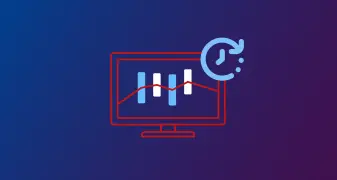Why the truly modern organization prioritizes sustainable IT infrastructure
Yes, it’s true. Even your software has a carbon footprint.
In an era dominated by technological advancements, the carbon footprint of information technology is rapidly becoming a cause for concern. In a recent webinar featuring industry experts Abhijit Sunil, Senior Analyst at Forrester Research, and Behrad Babaee, Technology Evangelist at Aerospike, the discussion revolved around the environmental impact of IT requirements and the pivotal role efficient software can play in mitigating the carbon emissions associated with IT.
IT has a sustainability problem
In the discussion, Babaee explains that while we rarely associate software with carbon footprints, the energy demand of software systems and the hardware infrastructure that supports them is substantial and what mainly results in IT carbon emissions.
Proper tracking and reporting of emissions is also essential to truly understand the environmental impact of technology. Sunil touches on the widely used framework developed by the GHG protocol to report carbon emissions. Scope 1 emissions are direct emissions from an organization. Scope 2 emissions are indirect and occur due to the energy an organization consumes. The organization can directly control both of these. Scope 3 emissions, however, are indirect and dependent on choices made by suppliers or customers.
Sunil’s research finds that emissions come from various sources within the IT stack, including data center and cloud infrastructure, end-user devices in the workplace, and software development and applications.
Data centers are global energy consumers and major Scope 1 and Scope 2 emissions sources. According to the International Energy Agency (IEA), data centers account for 1-1.5% of global energy consumption and 1% of energy-related greenhouse gas emissions. Babaee also shares that by 2030, the energy used to develop semiconductors is projected to match that of a country the size of Australia.
Even emerging technologies like artificial intelligence (AI), which are currently used for energy modeling to optimize data centers, pose a challenge as they demand significant energy resources on their own, according to Sunil. The MIT Technology Review reports that training a single AI model can emit more than 626,000 pounds of carbon emissions—that’s nearly five times the cumulative emissions of an average American car over its entire lifetime. Striking a balance between the innovation and optimization of these technologies will be crucial in the sustainable evolution of IT.
The case for efficiency
As technology advances and global data volumes inevitably continue to surge, it is necessary to consider both scaling and efficiency in software development. Babaee recalls that prior to the advent of the internet, efficiency in the technology industry equated to speed and making CPUs run faster to do more. As the internet became more prevalent and the tech giants emerged, there was a clear shift in focus to scalability because scalability equals growth. Your data workload has doubled? Great, your business is growing. Simply double the amount of hardware, and you’re all set. Your business can keep on growing.
But what if you had more efficient software? What if you could handle double the workload on the same amount of hardware?
“There’s been a seismic shift in the amount of hardware we have in different parts of the computer other than the CPU,” says Babaee. A couple of decades ago, the maximum amount of RAM on a single machine was 64 gigabytes. Fast forward to today, RAM can hold up to 24 terabytes on a single server. That’s almost 350 times the capacity and ten times the speed. This evolution in hardware underlines the potential for more efficient software.
In a white paper Babaee wrote in 2022, he compared the carbon emissions generated by Aerospike and competitor Apache Cassandra, revealing an 80% reduction in carbon emissions by adopting the more efficient software. Taking advantage of hardware innovations, Aerospike’s unique hybrid memory architecture enables it to use fewer servers than legacy solutions for the same high workloads, significantly lowering the total cost of ownership (TCO) and carbon footprint.
Let’s look at a couple of real-world use cases:
Criteo, one of the largest ad tech companies in the world, needed to reduce the number of computing resources they were using to meet their requirement of processing up to 200 million queries per second. With Aerospike, they reduced their server count from 5000 to 600, thereby significantly lowering their carbon emissions.
TomTom is a location technology specialist who does mapping and navigation for some of the world’s largest car manufacturers. By eliminating and replacing their caching layer with the Aerospike Database, they lowered their carbon emissions by 86% and reduced their server count from 49 to three.
A holistic approach to sustainability strategy
“So, how can companies create a sustainability strategy for themselves to reduce their emissions?” asks Babaee.Developing an IT sustainability strategy begins with understanding the sources of carbon emissions. We go back to the three main buckets Sunil previously outlined: hardware and data centers, end-user devices and the workplace, and software development and application sustainability. It’s also important to consider infrastructure manufacturing and end-of-life. What is the environmental impact of upgrading a server today versus in one year? What about manufacturing a new server or disposing of the legacy server?
With this framework, Sunil says, organizations can analyze which sources of emissions are the most impactful and which ones are the most pragmatic for them to address. Measuring your carbon footprint is difficult, but you can start by establishing metrics and KPIs to track and optimize your emissions.
Babaee suggests the industry should adopt a standardized approach for measuring and displaying carbon emissions from software technologies, akin to appliance energy efficiency labels. One of the non-functional requirements and key criteria for evaluating a software platform should be the amount of carbon emissions it will generate. With an established industry standard, buyers can make more informed decisions.
A commitment to sustainability
As we stand at the crossroads of technological innovation and environmental responsibility, IT’s carbon footprint trajectory is in our hands. It requires a collective commitment from industry leaders, organizations, and consumers alike. By embracing efficient technologies like Aerospike that optimizes hardware use and implementing sustainable practices, we can pave the way for a more environmentally conscious future. Start your free 60-day trial of Aerospike today.




